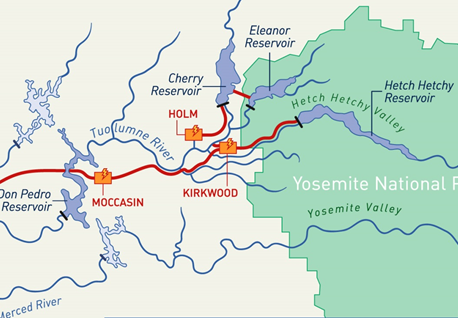
San Francisco’s greenwashing of “Hetch Hetchy Power” conveniently omits the spectacular landscape the City destroyed.
Baloney, i.e. nonsense: When someone says something completely ridiculous, call it a bunch of baloney.
Baloney is the most polite word that comes to mind after receiving the “Happy Earth Month from Hetch Hetchy Power!” notice from the San Francisco Public Utilities Commission earlier this week.
“Earth Month is a time to take climate action and reflect on the progress we’ve made to create a more sustainable San Francisco. Here at Hetch Hetchy Power, every day is Earth Day. From generating clean, greenhouse gas-free hydropower to constructing solar installations throughout the City, we’re leading San Francisco to a greener tomorrow.”
It’s hard to take this hyperbole seriously. Earth Month / Earth Day is no time to celebrate the historic destruction of Yosemite’s Hetch Hetchy Valley, and San Francisco’s greenwashing of its water and power project is objectionable.
Hydropower generation may be greenhouse gas-free, but it destroys rivers, and the fish and wildlife that depend on them as well as recreation opportunities. The California legislature, when adopting its “Renewable Portfolio Standard”, determined that large hydropower plants do not count as “renewable” power.
Electricity production in California has changed remarkably over the last several years. As solar and wind projects have become prevalent, there has been a marked decline in gas-fired electricity accompanied by some relatively minor decreases in hydropower production (e.g. Klamath and Trinity Rivers). Continued improvements in battery technology will help further the transition to renewable power.

The California Independent System Operator provides daily detail showing how electricity is generated. The green is “renewable” – mostly solar and wind. The purple shows batteries – charged by solar power during the day and providing electricity to homes and businesses in the evening.
When San Francisco advocated to dam Hetch Hetchy in preference to other alternatives, it did so largely because the project would provide hydropower as well as water supply. Restoration requires a plan to keep the City whole with respect to both. Our greatest challenge lies in the politics and expense of making improvements to assure there is no loss of water supply.

With restoration, Holm and Moccasin will be little affected. Generation at Kirkwood will only be possible with “run-of-river” flows.
Restoration, however, will also require replacing about 20% of the total production of San Francisco’s three principal hydropower plants. Only generation at the Kirkwood Plant will be significantly reduced – by about 350 gWh per year (roughly 1/2 of the reduction experienced when the Klamath Dams were removed).
We recognize that no form of electricity is entirely without impact. Solar power, coupled with improvements in the cost and safety of batteries, appears to be the future in California and elsewhere. Hydropower will be an increasingly less important part of the mix.
